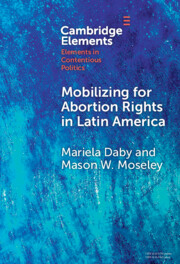Element contents
Mobilizing for Abortion Rights in Latin America
Published online by Cambridge University Press: 14 December 2023
Summary
- Type
- Element
- Information
- Series: Elements in Contentious PoliticsOnline ISBN: 9781009452724Publisher: Cambridge University PressPrint publication: 18 January 2024
References
- 6
- Cited by



